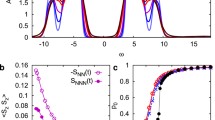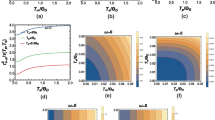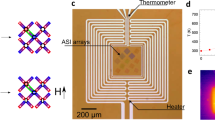Abstract
At temperatures below the magnetic anisotropy energy, monodomain magnetic systems (small particles, nanomagnetic devices, etc.) must relax quantum mechanically-thermal activation is ineffective. The discrete nature of the spectrum is important. This quantum relaxation must be mediated by the coupling to both nuclear spins and phonons (and electrons if either particle or substrate is conducting).
We analyze the effect of each of these couplings, and then combine them to get results for the physical relaxation of magnetic particles at low temperature and bias. This done for both conducting and insulating systems. The effect of electrons and phonons can be handled using “oscillator bath” representations; but the effect of environmental spins must be described using a “spin bath” representation of the environment, the theory of which was developed in previous papers.
Conducting systems can be modelled by a “giant Kondo” Hamiltonian, with nuclear spins added in as well. At low temperatures, even microscopic particles on a conducting substrate will have their magnetisation frozen over millenia by a combination of electronic dissipation and the “degeneracyblocking” caused by nuclear spins. Raising the temperature leads to a sudden unblocking of the spin dynamics at a well defined temperature. We analyze in turn the 3 different cases of (a) conducting substrate, conducting particle (b) conducting substrate, insulating particle, and (c) conducting particle, insulating substrate.
Insulating systems are quite different. The relaxation is strongly enhanced by the coupling to nuclear spins. At short times the magnetization of an ensemble of particles relaxes logarithmically in time, after an initial very fast decay-this relaxation proceeds entirely via the nuclear spins. At longer times phonons take over, but the decay rate is still governed by the temperature-dependent nuclear bias field acting on the particles-decay may be exponential or power-law depending on the temperature. Depending on the parameters of the particles and the environment, the crossover from nuclear spin-mediated to phonon-mediated relaxation can take place after a time ranging between fractions of a second up to months.
The most surprising feature of the results is the pivotal role played by the nuclear spins. The results apply to any experiments on magnetic particles in which interparticle interactions are unimportant (we do not deal with the effect of interparticle interactions in this paper). They are also relevant to future magnetic device technology.
Similar content being viewed by others
References
An account of the early history of magnetic research is given in Ch. I of D. C. Mattis, “The Theory of Magnetism,” Harper & Row, (1965).
Recent work in nanomagnetism is described in a collection of articles in “Physics Today,” April (1995).
I. Affleck,J. Phys. CM 1, 3047 (1989).
J. L. van Hemmen, S. Suto,Europhys. Lett. 1, 481 (1986),and Physica B 141, 37 (1986).
M. Enz and R. Schilling,J. Phys. C 19, 1765 (1986);ibid L 711 (1986).
P. C. E. Stamp,Phys. Rev. Lett. 66, 2802 (1991).
P. C. E. Stamp, E. M. Chudnovsky, and B. Barbara,Int. J. Mod. Phys. B 6, 1355 (1992).
B. Barbaraet al., J. Appl. Phys. 73, 6703 (1993).
“Quantum Tunneling of Magnetisation, QTM-'94,” Proc NATO conf. (Chichilienne, June 1994), ed. L. Gunther, B. Barbara, Kluwer Publishing (1995).
N. V. Prokof'ev and P. C. E. Stamp, UBC preprint (submitted April 1995), cond-mat 9511011; “Decoherence in the Quantum Dynamics of a Central Spin coupled to a spin environment” and UBC preprint (submitted Aug. 1995), cond-mat 9511015; “Quantum Coherence in Magnetic Grains.”
E. M. Chudnovsky and L. Gunther,Phys. Rev. Lett. 60, 661 (1988)
A. J. Leggettet al., Rev. Mod. Phys. 59, 1 (1987).
See “Theory of Mesoscopic Quantum Tunneling in Magnetism: a WKB Approach,” Chapter in Ref. 9, by J. L. van Hemmen and S. Suto, pp. 19–57.
P. Politiet al., Phys. Rev. Lett. 75, 537 (1995); see also J. Villainet al., Europhys. Lett. 27, 159 (1994).
A. O. Caldeira and A. J. Leggett,Ann. Phys. 149, 374 (1983).
A. Garg and G. H. Kim,Phys. Rev. Lett. 63, 2512 (1989).
S. N. Burmistrov and L. B. Dubovskii,Sov. Phys. JETP, (1984);ibid, (1992).
R. P. Feynman and F. L. Vernon,Ann. Phys. 24, 118 (1963).
A. Garg,Phys. Rev. Lett. 70, 1541 (1993).
K. Yamada,Prog. Theor. Phys. 72, 195 (1984); K. Yamadaet al, Prog. Theor. Phys. 75, 1030 (1986).
Yu. Kagan and N. V. Prokof'ev, “Quantum Tunneling in Solids,” Chapter in “Quantum Tunneling in Condensed Matter,” ed. Yu. Kagall and A. J. Leggett, Elsevier (1992). Note in particular that the equations (3.7, 3.9, 3.10) of the text are particular cases of equation (3.52) of this reference. Incidentally, these equations in the text are valid even when the field goes to zero. Thus, the phonon relaxation rate goes to zero with the field-this is of course because the photon bath does not distinguish the 2 giant spin states, as discussed in the text. Notice also that the discussion of the zero-field limit of the equations in Sec. 3 is entirely academic unless the magnetic grain has been completely isotopically purified. This is because the hyperfine coupling of a single nuclear spin to the giant spin will almost certainly exceed A o. One must then use the theory of Sec. 5. The results of Sec. 3 are simply an input to the complete theory in Sec. 5.
E. M. Chudnovsky,Phys. Rev. Lett. 72, 3433 (1994).
C. Paulsen and J. G. Park, Chapter in Ref. 9; andJMMM 140–144, 379 (1995).
P. C. E. Stamp,Physica B 197, 133 (1994).
N. V. Prokof'ev and P. C. E. Stamp,J. Phys. CM Lett. 5, L663-L670 (1993).
N. V. Prokof'ev and P. C. E. Stamp, “Spin Environments and the Suppression of Quantum Coherence,” Chapter in Ref. 9, pp. 347–371.
N. V. Prokof'ev and P. C. E. Stamp, UBC preprint (submitted July 1995), cond-mat 9511009; “Decoherence in the Spin Bath.”
P. W. Anderson,Phys. Rev. Lett. 18, 1049 (1967).
F. Coppingeret al., Phys. Rev. Lett. 75, 3513 (1995)
J. L. Simones, pp. 26–32 in Ref. 2.
M. Uehara, B. Barbara, B. Dieny, and P. C. E. Stamp,Phys. Lett. 114A, 23 (1986).
A. E. Berkowitzet al, Phys. Rev. Lett. 34, 594 (1975)
R. H. Kodamaet al., UCSD Preprint (Jan. 1996).
E. M. Chudnovsky, O. Iglesias, and P. C. E. Stamp,Phys. Rev. B 46, 5392 (1992).
G. Tatara and H. Fukuyama,Phys. Rev. Lett. 72, 772 (1994);J. Phys. Soc. Japan 63, 2538 (1994); and Chapter in Ref. 9, pp. 289–309.
L. Gunther, in Ref. 9, pp. 413–433
O. Kahn “Molecular Magnetism,” VCH publishers (1993), discusses this whole field; and a recent short review of large molecular magnets is in D. Gattseschiet al., Science 265, 1054 (1994).
For a collection of recent articles discussing magnetic relaxation of fine particles, see “Magnetic Properties of Fine Particles,” ed. J. L. Dormann, D. Fiorani (North-Holland, 1992).
R. Street and J. C. Wooley,Proc. Phys. Soc. 62, 562 (1949).
E. Shimshoni and Y. Gefen,Ann. Phys. 210, 16 (1991).
A. Garg,Phys. Rev. Lett. 74, 1458 (1995).
J. Waugh and C. P. Schlichter,Phys. Rev. B 37, 4337 (1988), have discussed this low-T T 1 problem; see also the Comment of T. Room,Phys. Rev. B 40, 4201 (1989), and reply by Waugh and Schlichter immediately following.
“Magnetostriction,” E. du T. de Lacheisserie, CRC Press, Florida (1993).
A. Burin, N. V. Prokof'ev, and P. C. E. Stamp, Phys. Rev. Lett.76, 3040 (1996), and reply of P. Politiet al. immediately following; and A. Burinet al., to be published.
J. R. Friedmanet al., preprint (Nov. 1995).
L. Thomaset al., preprint (March 1996).
G. Levine and J. Howard,Phys. Rev. Lett. 75, 4142 (1995).
G. Levine and J. Howard, erratum,Phys. Rev. Lett. 76, 3241 (1996).
N. Abarenkova, J.-C. Angles d'Auriac, preprint (April 1996).
D. D. Awschalomet al., Science 258, 414 (1992).
P. Politiet al., preprint (Dec. 1995).
Author information
Authors and Affiliations
Rights and permissions
About this article
Cite this article
Prokof'ev, N.V., Stamp, P.C.E. Quantum relaxation of magnetisation in magnetic particles. J Low Temp Phys 104, 143–209 (1996). https://doi.org/10.1007/BF00754094
Received:
Revised:
Issue Date:
DOI: https://doi.org/10.1007/BF00754094




